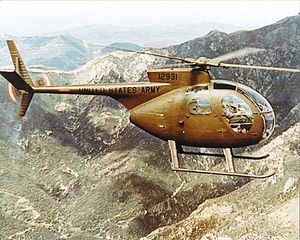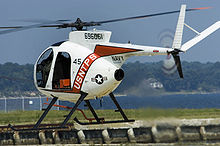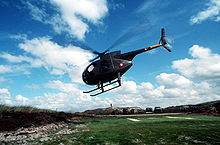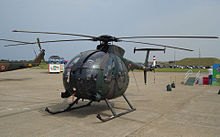- Hughes OH-6 Cayuse
-
"H-6" redirects here. For other uses, see H6 (disambiguation).
OH-6 Cayuse Right side view of the OH-6A Cayuse helicopter in flight. Role Light Observation Helicopter Manufacturer Hughes Tool Co. - Aircraft Division First flight 27 February 1963 Introduction 1966 Status Active service Primary user United States Army Produced 1965- Number built 1420 (OH-6A)[1] Unit cost US$19,860 (1966)[2][note 1] Variants MD Helicopters MH-6 Little Bird
MD Helicopters MD 500
McDonnell Douglas MD 500 DefenderThe Hughes OH-6 Cayuse (nicknamed "Loach", after the requirement acronym LOH - Light Observation Helicopter) is a single-engine light helicopter with a four-bladed main rotor used for personnel transport, escort and attack missions, and observation. Hughes Helicopters also developed the Model 369 as a civilian helicopter, the Hughes Model 500, currently produced by MD Helicopters as the MD 500.
Contents
Development
In 1960, the United States Army issued Technical Specification 153 for a Light Observation Helicopter (LOH) capable of fulfilling various roles: personnel transport, escort and attack missions, casualty evacuation and observation. Twelve companies took part in the competition and Hughes Tool Company's Aircraft Division submitted the Model 369. Two designs, those submitted by Fairchild-Hiller and Bell, were selected as finalists by the Army-Navy design competition board, but the U.S. Army later included the helicopter from Hughes as well.
The first Model 369 prototype flew on 27 February 1963. Originally designated as the YHO-6A according to the Army's designation system, the aircraft was redesignated as the YOH-6A in 1962 when the Department of Defense created a Joint designation system for all aircraft. Five prototypes were built, fitted with a 252 shp (188 kW) Allison T63-A-5A,[3] and delivered to the U.S. Army at Fort Rucker, Alabama to compete against the other 10 prototype aircraft submitted by Bell and Fairchild-Hiller. During the course of the competition, the Bell submission, the YOH-4, was eliminated[4] as being underpowered (it used the 250 shp (190 kW) T63-A-5). The bidding for the LOH contract came down to Fairchild-Hiller and Hughes. Hughes won the bid.,[5] and the Army awarded a contract for production in May 1965, with an initial order for 714 which was later increased to 1,300 with an option on another 114. Hughes's price was $19,700 per airframe, less engine, while Hiller's price was $27,000 per airframe, less engine. It should be noted that the Hiller design had a boosted control system, while the Hughes design did not. This would account for some of the price difference. Hughes is reported to have told Jack Real that he lost over $100 million in building 1,370 airframes.[6][7] It is reported that Hughes had directed his company to submit a bid at a price below the actual production cost of the helicopter in order to secure this order, resulting in substantial losses on the US Army deal, with the anticipation that an extended production cycle would eventually prove financially viable.[8][9]
In 1968 Hughes submitted a bid to build a further 2,700 airframes. Stanley Hiller complained to the US Army that Hughes had used unethical procedures, so the Army open the contract for rebidding by all parties. Hiller did not participate in the rebidding, but Bell did, with their redesigned Model 206. After a competitive fly-off, the Army asked for sealed bids. Hughes bid $56,550 per airframe, while Bell bid $54,200. Reportedly, Hughes had consulted at the last moment with his confidant Jack Real, who recommended a bid of $53,550. Hughes, without telling him, added $3,000 to the bid and thus lost the contract.[6][7]
Japanese OH-6
In Japan, 387 OH-6s were produced under licence by Kawasaki Heavy Industries and used by the Japanese Ground Self-Defense Force (JGSDF), Japanese Maritime Self-Defense Force (JMSDF), the Japanese Coast Guard, and civilian operators. Beginning in 2001, the OH-6s of the JGSDF are in the process of being replaced by Kawasaki's new observation helicopter, the Kawasaki OH-1.
Operational history
Shortly after production began, the OH-6 began to demonstrate what kind of an impact it would have on the world of helicopters. The OH-6 set 23 world records for helicopters in 1966 for speed, endurance and time to climb.[10] On 23 March 1966, Jack Schwiebold set the closed circuit distance record in a YOH-6A at Edwards Air Force Base, California. He flew without landing for 1,739.96 mi (2,800.20 km). Subsequently, on 7 April 1966, Robert Ferry set the long distance world record for helicopters. He flew from Culver City, California to Ormond Beach, Florida, covering a total of 1,923.08 nm (2,213.04 mi, 3,561.55 km).[11]
In 1964 the US Department of Defense issued a memorandum directing that all US Army fixed-wing aircraft be transferred to the US Air Force, while the US Army transitioned to rotor-wing aircraft. The US Army's fixed wing airplane, the O-1 Bird Dog, which was utilized for artillery observation and reconnaissance, would be replaced by the OH-6A helicopter.[12] The aircraft entered service in 1966, arriving in the Vietnam War thereafter. The pilots dubbed the new helicopter Loach, a word created by pronunciation of the acronym of the program that spawned the aircraft, LOH (light observation helicopter).
"The Quiet One"
A heavily-modified pair of OH-6As were utilized by the CIA via Air America for a covert wire-tapping mission in 1972. The aircraft, dubbed 500P (penetrator) by Hughes, began as an ARPA project, codenamed "Mainstreet", in 1968. Development included test and training flights in Culver City, California and at Area 51 in 1971. In order to reduce their acoustic signature, the helicopters (N351X and N352X) received a four-blade 'scissors' style tail rotor (later incorporated into the Hughes-designed AH-64 Apache), a fifth rotor blade and reshaped rotor tips, a modified exhaust system and various performance-boosts. Deployed to a secret base in southern Laos (PS-44) in June 1972, one of the helicopters was heavily damaged during a training mission late in the summer. The remaining helicopter deployed a wiretap near Vinh, Vietnam on the night of 5–6 December 1972, which provided the United States with useful information during the Linebacker II campaign and Paris Peace Talks. Shortly thereafter, the aircraft were returned to the U.S., dismantled and quietly found new homes as the now-standard 500s.[13]
160th Special Operations Aviation Regiment
Further information: MH-6 Little BirdFollowing the April 1980 failure of Operation Eagle Claw (the attempted rescue of American hostages in Tehran), it was determined that the military lacked aircraft and crews who were trained and prepared to perform special operations missions. To remedy this shortcoming, the Army began developing a special aviation task force to prepare for the next attempt to rescue the hostages: Operation Honey Badger.
Task Force 160
The architects of the task force identified the need for a small helicopter to land in the most restrictive locations and that was also easily transported on Air Force transport aircraft. They chose the OH-6A scout helicopter to fill that role, and it became known as the Little Bird compared to the other aircraft in the task force, the UH-60A and the CH-47C. As a separate part of the project, armed OH-6As were being developed at Fort Rucker, Alabama.[14]
The pilots selected to fly the OH-6A helicopters came from the 229th Attack Helicopter Battalion and were sent to the Mississippi Army National Guard's Army Aviation Support Facility (AASF) at Gulfport, Mississippi, for two weeks of qualification training in the aircraft. When the training was completed, C-141 aircraft transported the aircraft and crews to Fort Huachuca, Arizona, for two weeks of mission training. The mission training consisted of loading onto C-130 transport aircraft which would then transport them to forward staging areas over routes as long as 1,000 nautical miles (1,900 km). The armed OH-6 aircraft from Fort Rucker joined the training program in the fall of 1980.[15]
Operation Honey Badger was canceled after the hostages were released on 20 January 1981, and for a short while, it looked as if the task force would be disbanded and the personnel returned to their former units. But the Army decided that it would be more prudent to keep the unit in order to be prepared for future contingencies. The task force, which had been designated as Task Force 158, was soon formed into the 160th Aviation Battalion. The OH-6A helicopters used for transporting personnel became the MH-6 aircraft of the Light Assault Company and the armed OH-6As became the AH-6 aircraft of the Light Attack Company.
On 1 October 1986, to help meet the increasing demands for support, the 1-245th Aviation Battalion from the Oklahoma National Guard, which had 25 AH-6 and 23 UH-1 helicopters, was placed under the operational control of the 160th. The 1-245th AVN BN enlisted were sent to the Mississippi Army National Guard's Army Aviation Support Facility (AASF) at Gulfport, Mississippi, for two weeks of qualification training in the aircraft. The following 2 week mission was to Yuma for night operation training. The AH/MH little birds were lifted by, 1 C-5, 2 C-130 along with all support kits for the Battalion. Crews trained side by side with the 160th for all operational concepts. The 1-245 modified infantry night vision goggles and worked to develop the necessary skills for rapid deployment with little birds and C-130's.[16]
Variants
- YOH-6A
- Prototype version.
- OH-6A
- Light observation helicopter, powered by a 263 kW (317 shp) Allison T63-A5A turboshaft engine.
- OH-6A NOTAR
- Experimental version.
- OH-6B
- Re-engined version, powered by a 298 kW (420 shp) Allison T63-A-720 turboshaft engine.
- OH-6C
- Proposed version, powered by a 313.32 kW (400 shp) Allison 25-C20 turboshaft engine, fitted five rotor blades.
- OH-6J
- Light observation helicopter for the JGSDF. Built by Kawasaki Heavy Industries under licence in Japan. Based on the OH-6A Cayuse helicopter.
- OH-6D
- Light observation, scout helicopter for the JGSDF. Built by Kawasaki Heavy Industries under licence in Japan. Based on the Hughes Model 500D helicopter.
- EH-6B
- Special Forces electronic warfare, command post version.
- MH-6B
- Special Forces version.
- TH-6B
- A Navy derivative of the MD-369H, six McDonnell Douglas TH-6B Conversion-in-Lieu-of-Procurement aircraft are used as an integral part of the United States Naval Test Pilot School's test pilot training syllabus. The aircraft and associated instrumentation and avionics are used for the in-flight instruction and demonstration of flying qualities, performance and missions systems flight test techniques.[17]
- AH-6C
- Modified OH-6A to carry weapons and operate as a light attack aircraft for the 160th SOAR(A).
- MH-6C
- Special Forces version.
For other AH-6 and MH-6 variants, see MH-6 Little Bird and Boeing AH-6.
Operators
- Argentine Air Force
- Argentine Coast Guard (Retired)
- Fuerza Aérea Colombiana
- Policia Nacional
- Japan Coast Guard
- Japan Ground Self Defense Force
- Japan Maritime Self Defense Force
- Republic of China Navy: 13 500MD ASW Defender
- Republic of China Marine Corps: OH-6 Cayuse
Specifications
General characteristics
- Crew: 2
- Length: 30 ft 10 in - 32 ft 2 in (9.4 m - 9.8 m)
- Rotor diameter: 27 ft. 4 in (8.33 m)
- Height: 8 ft 6 in - 11 ft 2 in (2.6 m - 3.4 m)
- Empty weight: 1,975 lbs (896 kg)
- Max takeoff weight: 3,549 lbs (1,610 kg)
- Powerplant: 1 × One Allison T63-A-5A or T63-A-700 turboshaft, 317 hp (236 kW)
Performance
- Maximum speed: 152 knots (175 mph, 282 km/h)
- Cruise speed: 135 knots (155 mph, 250 km/h)
- Range: 232 nm (430 km (267 mi))
- Service ceiling: 15,994 ft (4,875 m)
- Rate of climb: 2,067 ft/min (10.5 m/s)
Armament
- Guns: Two M60 or M134 Minigun 7.62 mm machine guns; Two .50 cal (12.7 mm) MG pods
- Rockets: Fourteen 2.75 in (70 mm) Hydra 70 rockets in two pods
- Missiles: Four TOW missiles in two pods; Four Hellfire missiles in two pods[citation needed]
See also
- Related development
- MH-6 Little Bird
- MD Helicopters MD 500
- MD 500 Defender
- Boeing AH-6
- Aircraft of comparable role, configuration and era
- Related lists
References
- Notes
- ^ Holley and Sloniker state that Hughes underbid the competition to buy-in to the contract.
- Citations
- ^ Francillon 1990, p. 248.
- ^ Holley and Sloniker 1997, p. 8.
- ^ "FAA Document in PDF format." FAA. Retrieved: 22 September 2010.
- ^ "Hughes OH-6 "Cayuse" / MD 500 / MD 530 helicopter - development history, photos, technical data." Avia. Retrieved: 20 May 2011.
- ^ "Hughes Aircraft." Centennial of Flight Commission, 2003. Retrieved: 22 September 2010.
- ^ a b Cefaratt 2002, p. 77.
- ^ a b Real, Jack. "The Real Story." Vertiflite, Fall/Winter 1999, pp. 36–39.
- ^ Real, Jack G. and Bill Yenne. The Asylum of Howard Hughes. Bloomington, Indiana: Xlibris Corp, 2003. ISBN: 978-1413408768.
- ^ Day, Dwayna Q. "Monster chopper." The Space Review, 28 January 2008. Retrieved: 20 May 2011.
- ^ "History of Rotorcraft World Records, List of records established by the 'YOH-6A'." Fédération Aéronautique Internationale (FAI). Retrieved: 11 January 2011.
- ^ "Rotorcraft World Records, Absolute Rotorcraft World Records." Fédération Aéronautique Internationale (FAI). Retrieved: 11 January 2011.
- ^ Adcock 1998, p. 32.
- ^ Chiles, James R. Air America's Black Helicopter. Washington: Air & Space Smithsonian (Smithsonian Business Ventures), February–March 2008, pp. 62–70. ISSN 0886-2257. Retrieved: 6 February 2008.
- ^ Durant and Hartov 2006, pp. 48–49.
- ^ Durant and Hartov 2006, p. 56.
- ^ Durant and Hartov 2006, p. 57.
- ^ "Navy fact sheet." navy.mil. Retrieved: 22 September 2010.
- Bibliography
- Adcock, Al. O-1 Bird Dog In Action. Carrollton, Texas: Squadron Signal Publications number 87, 1988. ISBN 0-89747-206-3.
- Cefaratt, Gil. Lockheed: The People Behind the Story. Nashville, Tennessee: Turner Publishing Company, 2002, ISBN 978-1563118470.
- Durant, Michael J. and Steven Hartov. The Night Stalkers. New York: G. P. Putnam's Sons, New York, 2006. ISBN 0-399-15392-6.
- Francillon, René J. McDonnell Douglas Aircraft Since 1920. Annapolis, Maryland: Naval Institute Press, 1988. ISBN 978-1557505507.
- Holley, Charles and Mike Sloniker. Primer of the Helicopter War. Grapevine, Texas: Nissi Pub, 1997. ISBN 978-0944372111.
External links
- Warbird Registry - OH-6 Cayuse - Tracking the histories of OH-6 that survived military service.
Hughes Aircraft/Hughes Helicopters Fixed-wing aircraft Experimental helicopters Civil helicopters Military helicopters Communications satellites Intelsat I · Syncom · TDRS · GOES
Spacecraft Surveyor I · Pioneer Venus
Avionic/Fire Control Systems Missile Systems United States Army helicopter designations 1956-1962 Helicopter, Cargo Helicopter, Observation Helicopter, Utility HU-1
Helicopter, Experimental USAAC/USAAF/USAF/Joint Service Helicopter designations 1941– Numerical sequence used by USAAC/USAAF/USAF 1941–Present; US Army 1948–1956 and 1962–present; US Navy 1962–presentMain sequence
Prefix R-, 1941–1948
Prefix H-, 1948–1962
H- with a mission prefix 1962–presentR-1 • R-2 • R-3 • R-4 • R-5/H-5 • R-6/H-6 • R-7 • R-8 • R-9/H-9 • R-10/H-10 • R-11/H-11 • R-12/H-12 • R-13/H-13/OH-13/UH-13J • R-14 • R-15/H-15 • R-16/H-16 • H-17 • H-18 • H-19/UH-19 • H-20 • H-21/CH-21 • H-22 • H-23/OH-23 • H-24 • H-25/UH-25 • XH-26 • H-27 • H-28 • H-29 • H-30 • H-31 • H-32 • H-33 • H-34/CH-34 • H-35 • (H-36 not assigned) • H-37/CH-37 • (H-38 not assigned) • XH-39 • H-40 • H-41 • H-42 • H-43/HH-43 • (H-44 and H-45 not assigned) • CH-46/HH-46 • CH-47 • UH-48 • H-49 • QH-50 • XH-51 • HH-52 • CH-53/HH-53/MH-53 • CH-54 • TH-55 • AH-56 • TH-57 • OH-58 • XH-59 • UH-60/SH-60/HH-60 • YUH-61 • XCH-62 • YAH-63 • AH-64 • HH-65 • RAH-66 • TH-67 • MH-68 • (H-69 not assigned) • ARH-70 • VH-71 • UH-72
1962 redesignations
reusing old numbersLists relating to aviation General Aircraft (manufacturers) · Aircraft engines (manufacturers) · Airlines (defunct) · Airports · Civil authorities · Museums · Registration prefixes · Rotorcraft (manufacturers) · TimelineMilitary Accidents/incidents Records Categories:- Military helicopters
- United States attack aircraft 1960–1969
- United States military utility aircraft 1960–1969
- Military aircraft of the Vietnam War
- Kawasaki aerospace
- United States helicopters 1960–1969
- Hughes aircraft
Wikimedia Foundation. 2010.




